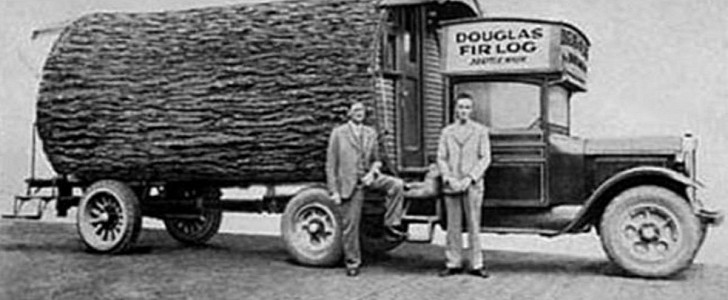These past couple of years have not been as we had expected. As the clock is ticking on a surprising, mostly unpleasant 2021, it’s time to look back and try to find the good things among the bad and hope for a brighter 2022.
With the ongoing international health crisis, humanity was forced to recenter itself, to reevaluate, adapt and overcome – it sounds like a cliché, but it’s the truth. Social and travel restrictions meant a new approach to everyday life, including work, family time, or traveling, which, in turn, contributed to the growing popularity of RVs, tiny homes, and other types of transportation.
As stated above, the year’s end marks an onslaught of listicles. This is different because, to celebrate today’s trendy tiny houses, we’re throwing it all the way back – to the early 1920s. That’s when the OG tiny home wandered the roads of the good U.S. of A, the Douglas fir log motorhome.
Like its name says, it was a motorhome made entirely out of Douglas fir. As in, it was a single Douglas fir that had been hollowed out and then turned into a mobile home. Built for married couple E. A. Wade of Aberdeen, Washington, the log motorhome sat on a 1920 3-ton Dodge Brothers chassis, and offered all the creature comforts of home, but on the road.
The monster motorhome was completed in 1926 and set out on great adventures in October of that year. To build it, a 434-year-old Douglas fir was cut down; it measured 9.4 feet (286.5-cm) in diameter and was 311 feet (9,479 cm) high. The lumber from the entire tree could have been used to build four 6-room houses, and the 8 by 16 feet (244 by 488 cm) section used for the motorhome took a team of three men five whole weeks just to hollow out.
The process started with drilling a 2-inch (5-cm) hole throughout. The hole was then burned to 4 feet (122 cm) in diameter and then finished up with an electric buzz saw. The furniture inside was also made of wood, with the interior housing a bedroom area, a kitchen and dining space. It wasn’t exactly fancy-living by today’s standards, but it must have been so back then. “A complete wee home in a Douglas fir log” is how the 1926 brochure advertising it described it.
No word on how long the Wades used it, or how successful their on-the-road adventures were. It is believed that the motorhome, or one that resembles it, is now on display at the Redwood Museum in Northern California.
As stated above, the year’s end marks an onslaught of listicles. This is different because, to celebrate today’s trendy tiny houses, we’re throwing it all the way back – to the early 1920s. That’s when the OG tiny home wandered the roads of the good U.S. of A, the Douglas fir log motorhome.
Like its name says, it was a motorhome made entirely out of Douglas fir. As in, it was a single Douglas fir that had been hollowed out and then turned into a mobile home. Built for married couple E. A. Wade of Aberdeen, Washington, the log motorhome sat on a 1920 3-ton Dodge Brothers chassis, and offered all the creature comforts of home, but on the road.
The monster motorhome was completed in 1926 and set out on great adventures in October of that year. To build it, a 434-year-old Douglas fir was cut down; it measured 9.4 feet (286.5-cm) in diameter and was 311 feet (9,479 cm) high. The lumber from the entire tree could have been used to build four 6-room houses, and the 8 by 16 feet (244 by 488 cm) section used for the motorhome took a team of three men five whole weeks just to hollow out.
The process started with drilling a 2-inch (5-cm) hole throughout. The hole was then burned to 4 feet (122 cm) in diameter and then finished up with an electric buzz saw. The furniture inside was also made of wood, with the interior housing a bedroom area, a kitchen and dining space. It wasn’t exactly fancy-living by today’s standards, but it must have been so back then. “A complete wee home in a Douglas fir log” is how the 1926 brochure advertising it described it.
No word on how long the Wades used it, or how successful their on-the-road adventures were. It is believed that the motorhome, or one that resembles it, is now on display at the Redwood Museum in Northern California.








